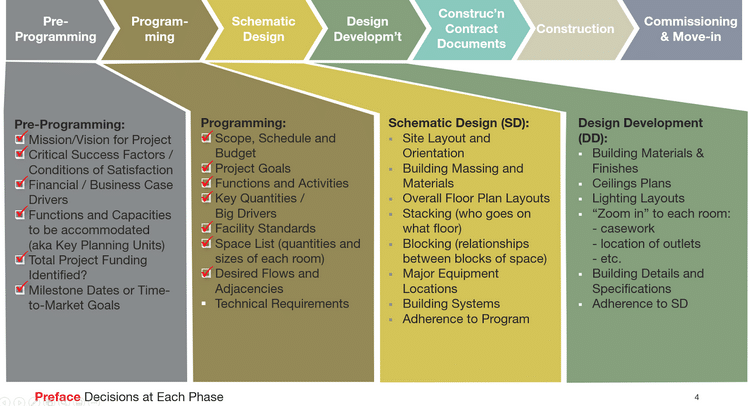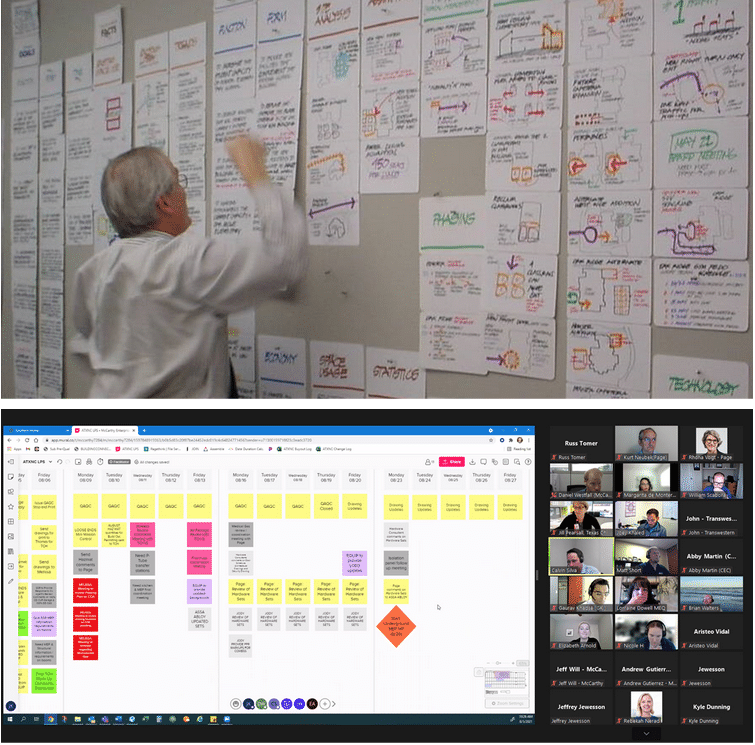In Part I of this series Getting Decisions that Stick, we looked at the psychology of decisions and what information people need to make decisions. Part II describes ten techniques to help decision-makers make better-informed decisions, including the importance of identifying the decision-makers and making it clear to them which decisions will be needed by when. (If you have not read those, you might benefit from reading them first.) This final segment of the series is covered in two blogs and focuses on more hands-on or actionable tools and tactics that project teams can use today to help people make decisions that will stick.
Brief recap: Better-informed decision-makers
Most people in the design and construction industry have experience on projects that were troubled by indecision or changing decisions, often causing strife and costing many project participants time and money. What project team members often do not recognize is how much they may be contributing to the problem! Too often, project teams ask owners or users or other team members to make a decision without providing all the information they will need to make an informed decision. I have found that when asked for a decision, people will choose what they believe is the best available option based on the information they have at the time. The problem is, if they later find information that would have influenced their decision (especially related to cost, schedule, or other quantitative and qualitative characteristics important to them), then the new information may cause them to change their previous decision—triggering rework and delays.
This phenomenon (judging which available alternative is best based on the information at hand) is not limited to design and construction projects; it happens to all of us every day, in every decision we make. The remedy is clear: Project teams who commit to helping decision-makers make better-informed decisions the first time are more likely to get decisions that stick. Durable decisions reduce rework and delays, helping the project stay on schedule and budget. They can also significantly improve the morale of the entire project team and help achieve other Conditions of Satisfaction the team may have established.
___________________________________________________________________________________________________________
Who are Decision-Makers?
Throughout this article, the term “decision-maker” refers to the many people who make decisions during the design and construction process. The “owner” of a project is the most obvious decision-maker, or whatever executive committee reviews and approves the countless decisions that go into a building. On large projects, there may be a series of user groups, facilities staff, and executive committees who get to review and comment. Even when they don’t approve or make the ultimate decision, if they have the authority to provide feedback that the project team needs to respond to, then they are effectively decision-makers. For projects using an Integrated Form of Agreement or Target Value Delivery, there may be cluster teams, core team leaders, and senior management teams who have the authority to make various levels of decisions. Authorities having jurisdiction (AHJs) are certainly decision-makers, and design and construction teams need to understand their unique decision criteria in addition to the known project criteria. Members of the design team are also decision-makers, whether a programmer, planner, designer, architect, engineer, specifier, or another consultant. Since these people develop and narrow the list of concepts to be reviewed and approved by others, they are among the earliest project decision-makers. As the project progresses into detailed design and construction details, there may be other technical reviewers and construction representatives who get to weigh in on the constructability or maintainability of various design details. And during the construction phase, the contractor and trade partners certainly make decisions and judgement calls. Many, but not all, of these decisions need to be reviewed and approved by the owner, architect, or engineers. Certifiers and commissioning agents often carry the weight of an AHJ, and they may have their own criteria that the project team needs to know from the beginning. All of the people mentioned above are decision-makers in the design and construction process.
_____________________________________________________________________________________________________________
Tools and tactics to make better-Informed decisions
- Explain to everyone which decisions are needed when
- Facilitate to foster informed decision-making
- Use high tech and high touch
- For data-informed decisions, make data actionable
- But don’t bet the farm on the data! Plan flexibility
- Facilitation techniques to make deciding easy
- Communicate cost and schedule impact early and often
- Recognize that most customers don’t understand floor plans
- A3s
- For really tough decisions, flip a coin
- Explain to everyone which decisions are needed when
The design and construction process is, at its core, a recognized way to make all the decisions needed to complete a construction project. An important determinant of whether a project is judged as successful is whether decisions were made when needed and whether those decisions were overturned later–causing rework and delays. Therefore, project teams need to make visible to everyone involved, including all of the team members and certainly all of the decision-makers, which decisions are needed when to keep the project on schedule. I have used the following diagram successfully for many projects. It conveys to people which decisions are needed at which phase, and we use it to explain the differences between design phases. The following sample chart focused on decisions through Design Development and highlighted the decisions that had already been made at that point.

Illustration Kurt Neubek
Charts like this have been enormously beneficial to project teams, and especially to “users” who may not be familiar with the design and construction process. I remind people that together we only have enough time and money to design and build this project once. Once established, the project’s opening date and the budget are maximums that are rarely negotiable. So decisions need to be made moving from left to right on the chart, stressing to the team that we cannot afford to go backwards. We reinforce this by saying, at each phase, “Speak now or forever hold your peace.” For example, I explain that decisions about the number of rooms, the size of rooms, and the desired relationship between rooms are programmatic decisions, not design decisions. They need to be made during the programming phase. Anyone who wants or needs to weigh in on those decisions needs to participate during the programming phase. Once we get into schematic design, we focus on the arrangement of those agreed-to spaces, and it is too late to ask for changes in the program.
Right now, some of you are thinking, “That’s not how my clients or users think.” I am sure that is true, and it is exactly why project team leaders need to explain that this is how the design process works and these times are when certain decisions will be made. Once they understand the process and when their participation is needed, users and decision-makers will be much more likely to give you input when needed and to make timely decisions.
Incidentally, I hear far too many people (even architects) say “But the design process is iterative,” perhaps as a way to justify a team’s inability to make timely decisions. But iteration means the repetition of a process, so within any given phase there will certainly be iterations, with options being explored, revised, and optimized. But the decisions and processes at each phase are different, and making those differences clear from the beginning helps to get decisions made at each phase. Project teams need processes and tools in place to drive the project team toward making durable decisions at each phase, reducing out-of-sequence iterations.
2. Facilitate to foster informed decision-making
In Part II of this series, I told the story of how, during live presentations on this topic, I get the audience members to make a simple decision: “Which lunch would you prefer, A, B, or C?” It turns out that audiences keep changing their minds depending on what information I provide with the same three choices. The exercise is very effective in getting people to recognize that when projects are plagued with indecision or changing decisions, the project team needs to recognize how much they may be contributing to the problem by the way they ask for decisions. Put concisely, the obvious countermeasure to this problem is for project teams to spend more time facilitating decisions than just asking for decisions. It is neither reasonable nor respectful to expect a decision-maker or committee to understand all of the pros and cons, risks and rewards, and subtle implications between the options available without the assistance of the relevant professionals on the team.
The dictionary defines facilitate as, “to help (something) run more smoothly and effectively.” To facilitate a decision, before we ask someone to make a decision, we need to ask ourselves, “What information will they need to make an informed decision? What information or analysis might they ask for which would make the decision process more smooth and effective?” As explained in Part I, for project-related decisions, decision-makers generally want to know:
A. What is the question being asked and/or the problem we’re trying to solve? Make this very clear and concise (not some vague rambling problem), and word it in a way that can be answered. Otherwise, multiple decision-makers may be solving different perceived problems–which does not build consensus and can lead to indecision.
B. What are the options available? Clearly lay out the known constraints, the range of what’s possible, and why certain options have risen to the top for evaluation. And do not underestimate the possibility that intelligent, experienced executives may not agree that you have explored all of the options. If you are not thorough in your assessment and explanation of the available options, the decision-makers may very well identify other options they will ask you to explore.
C. Decision-makers then try to evaluate for themselves, “Which of the available options best answers the question or solves the problem?” And they generally think:
a. Functions/Qualifications/Prerequisites: Do all of the options meet the primary purpose and stated functional requirements? Are there any options we can rule out or put at the bottom of the list for these reasons? This line of thinking applies whether a committee is selecting a design or build team, choosing between major design concepts, or choosing between mechanical systems, for example.
Incidentally, I recommend design teams always make options “apples-to-apples” in this category. Don’t even propose an option that doesn’t meet the minimum requirements or key planning units. Doing so will either waste everyone’s time or, if that option were selected, will lead to more revisions later when the impact of the fundamental inadequacy is better understood. Furthermore, by encouraging revising the core criterion, it triggers re-evaluating other decisions that were based on that threshold.
b. Cost and Schedule - These categories are almost always the next to be evaluated. Make this easy to understand. A bar chart or a scatter chart can help convey these metrics at a glance. Decision-makers want to know if there is a clear front-runner and/or if there are options that can easily be eliminated.
c. Qualitative - If there is not a clear winner after the above evaluations, then decision-makers look for other criteria to help stratify the remaining options and provide a sound rationale for a decision. Depending on the question, they may look for other pros and cons, costs versus benefits, risks versus rewards. They may look at criteria such as which option provides greater flexibility to accommodate changes, is deemed more sustainable, provides a better image, is more consistent with the organization’s mission, or is likely to be more politically more acceptable.
The more a project team can anticipate the relevant criteria and provide insightful analyses, the better-informed the decision will be and the more likely those decisions will be made once and will stick.
3. Use high tech and high touch
As mentioned in Part I, we all learn through some combination of visual, auditory, and kinesthetic (experiential) input. Therefore, the most effective way to communicate is by addressing all of those. When presenting materials to ask someone for a decision, do not rely on only words or only numbers, even if, for you personally, one mode would be enough. Many (perhaps most) people respond extremely well to a combination of high tech and high touch.
Pull planning, for example, is extremely effective because it is inclusive and respects the input of the people who will be doing the work. But it is also effective because it is “high touch.” Keeping the communication media simple and visible—whether with sticky notes, flip charts, or analysis cards—engages people in a way that computer displays and print-outs do not. These tactile tools are much more effective at encouraging interaction, collaboration, and thinking. I have found this to be true even with “virtual” sticky notes used during videoconferences and other collaborative but distanced work sessions.
But for most decisions, people want some “hard” data as well. Therefore, a combination of high-tech (numbers, charts, maps, etc.) and high touch has shown over decades of use to be extremely effective.

Images: Kurt Neubek
4. For data-informed decisions, make data actionable
Almost all decision-makers prefer to make “data-driven” or “data-informed” decisions versus relying solely on intuition or faith in someone’s recommendation or “by the seat of their pants,” at least if there are costs involved. So getting data that is relevant to the question is an important step. But to make a decision, we have to recognize that data is not information, and information is not knowledge. Someone–or a group of people–from the project team needs to search and obtain relevant data, analyze it to understand what it tells us, then summarize and present the relevant data in a way that helps others make a decision. In short, to help people make better-informed decisions, yes, start with the available data, but then analyze it, distill it to its essence, and present a cogent, actionable summary.
Some project examples:
a. When trying to decide how large a facility should be, just having access to demographic data alone does not tell us anything. Instead, being able to see a graph of historical population data and official forecasts for the coming years provides a way to better understand the demographic history and trends, which helps to inform how large of a facility may be needed.
b. When establishing a project budget, getting cost data for similar facilities is a good start. But then each data point needs to be adjusted for location factor and escalation (projected construction cost inflation) to adjust what those buildings would have cost if built in this project’s city at the time this one is forecast to be built. Still further analysis of the data—such as sorting or colour-coding the projects that are most similar, or those that were built for similar owners—may also reveal information that would lead to better-informed decisions.
c. Many decision-makers feel reassured that they are making a better decision when the options have received a rigorous comparison. We learn new things and make decisions by comparing information to what we already know. So be sure to include, in any comparison, other information that the decision-makers already know. For example, showing how a needed decision compares to the owner’s other facilities or to known peers or competitors’ facilities provides a perspective that enhances one’s confidence that they are making an informed decision

5. But don’t bet the farm on the data! Plan flexibility.
Despite their desire for data-driven decisions, experienced decision-makers also know that every forecast is based on assumptions. Many will want to understand the most critical assumptions—the Achilles’ Heel in the logic—and the impact on the decision if that assumption is wrong or when things change over time. Therefore, project teams also need a thorough grasp of the weak links in the assumptions. While spreadsheets and other software can help teams easily explore various “what if” scenarios, they also make it easy to get caught in “analysis paralysis” and exploration of a seemingly endless list of options.
To help avoid that fate, project teams can:
a. Think Beyond the Current Decision - As noted earlier, decision-makers will do their best to 1) understand the decision they are being asked to make, 2) understand the options available, then 3) judge each option in light of the selection criteria. So it helps to pose the question in a way that reflects the long term reality of construction. For example, when deciding between multiple HVAC systems, presenting only the construction costs promotes short-term thinking. Instead, if the team presents and compares the life cycle costs, the choice of systems will often be different than if only the first cost is presented. And since the decision-makers can see that the comparison is comprehensive, they are less likely to ask questions that require another round of analysis, delaying the decision.
b. Plan Flexibility - Often, when options are effectively equivalent in terms of scope, schedule, budget, and other data-driven aspects, then qualitative differences such as flexibility may be the deciding factor. Put another way, a solution that both meets the projected needs and can flex to accommodate changes with little to no cost premium is almost always judged as the better option. But planning for flexibility should be more than just dashing in future expansion zones on the site plan. Some valuable approaches for design and construction teams include:
i. Problem Seeking, the widely-recognized standard for architectural programming, stresses that teams need to work with owners to identify the types of changes foreseeable at the proposed location so the design team can develop appropriate responses. While expansibility, adaptability, and convertibility are commonly recurring concepts, teams should not be limited to those. Other strategies might include the ability to sell off part of the property, or the ability to bring in temporary buildings. How might your current facilities have been different if one of the flexibility scenarios discussed had been, “Continue operations uninterrupted even in a pandemic with airborne transmission”?
ii. Scenario Planning, popularized in the book The Art of the Long View, acknowledges that if you try to predict the future, you will almost always be wrong. (And yet, that’s what most project teams do!) Instead, it is better to explore “alternative futures” that might develop and prepare strategies today that position you to succeed in any of those situations. For example, a large national corporation may recognize that an internal reorganization could dramatically change the facility needs at this location before the building is even completed. Understanding these scenarios will likely lead to more readily-adaptable design and construction solutions than those that would be developed assuming conventional one-future thinking.
By using such approaches, the design and construction process is less likely to be derailed when a significant change happens (or a fundamental assumption does not happen) because the project has already been planned to address such changes.
Previous articles from this author
Getting Decisions that Stick, Part I
You Cannot Speak of the Ocean to a Well Frog
Feature image: Jordan Ladikos via Unsplash
Kurt Neubek is a Principal, Firmwide Healthcare Practice Leader, and Lean Advocate with Page, a 650-person architecture/engineering/interiors/planning/consulting firm with nine offices across the US and abroad. He has over 30 years of experience and has programmed and planned tens of millions of square feet of space across the globe. Kurt is an award-winning speaker, having presented at more than 90 national and regional conferences. He is a Fellow in both the American Institute of Architects and the Health Facility Institute, a Certified Facility Manager, LEED Accredited, Evidence-based Design Accredited and Certified, and a Six Sigma Black Belt. He is also an instructor for the Lean Construction Institute and the Construction Owners Association of America.




